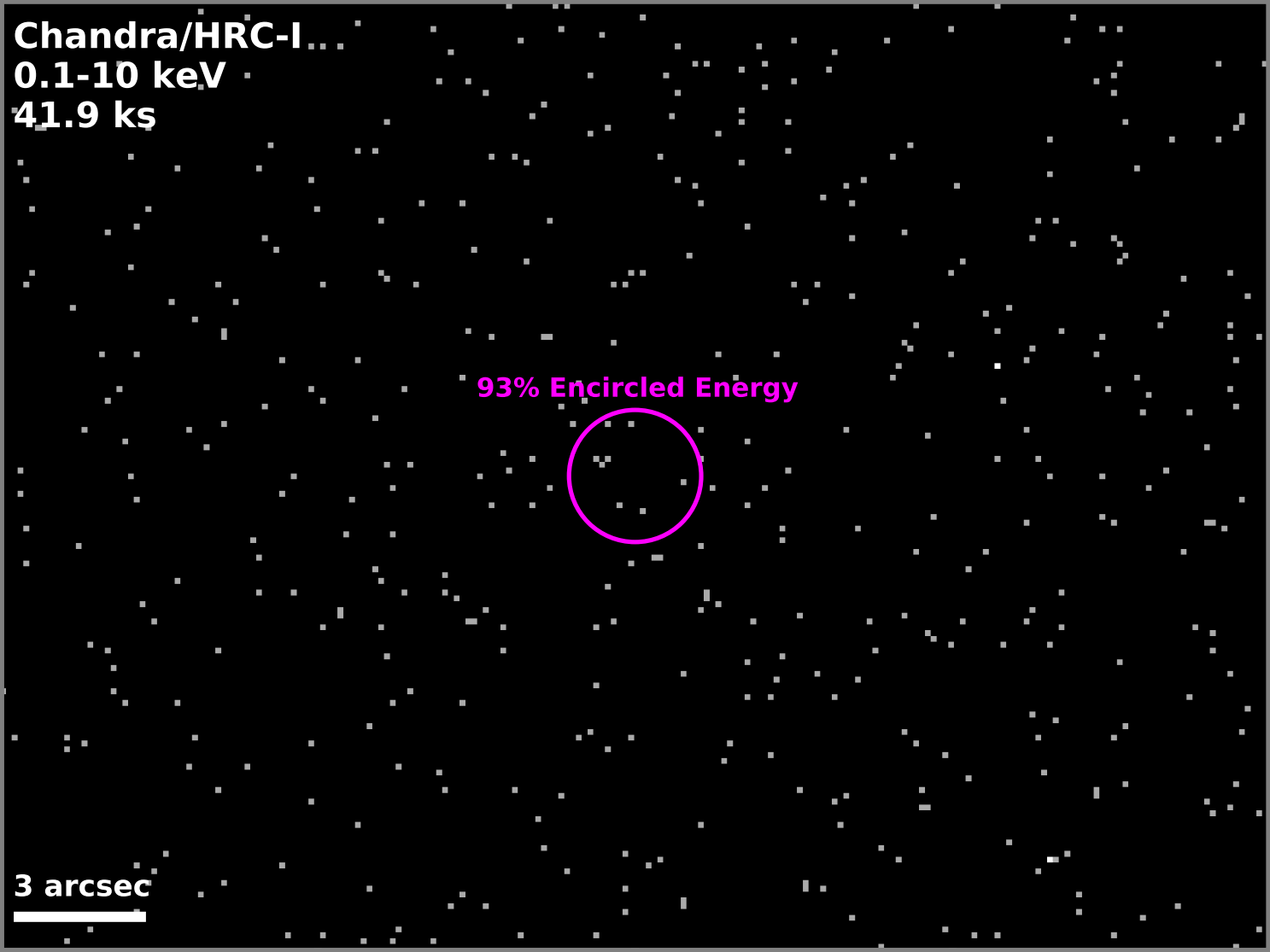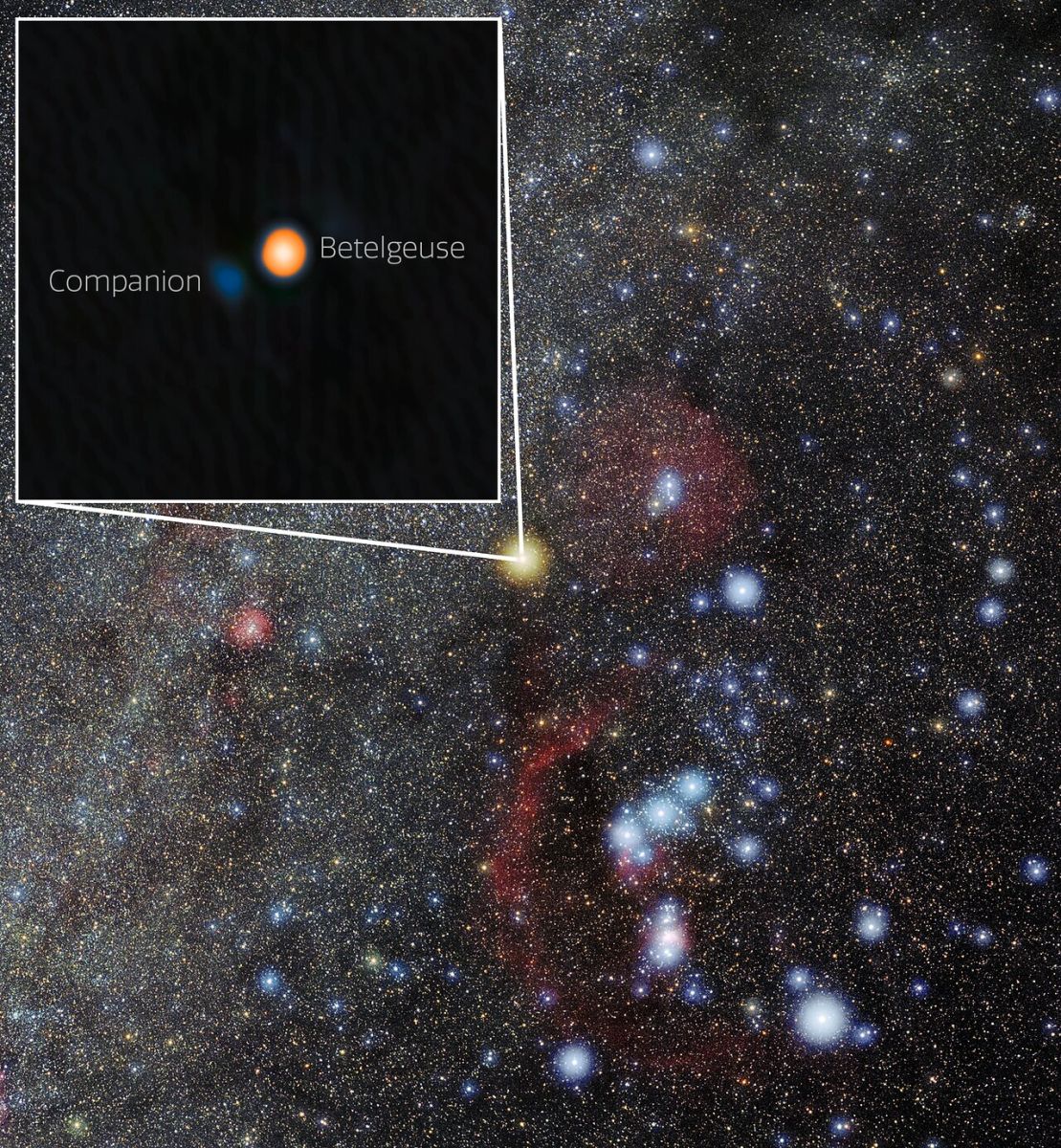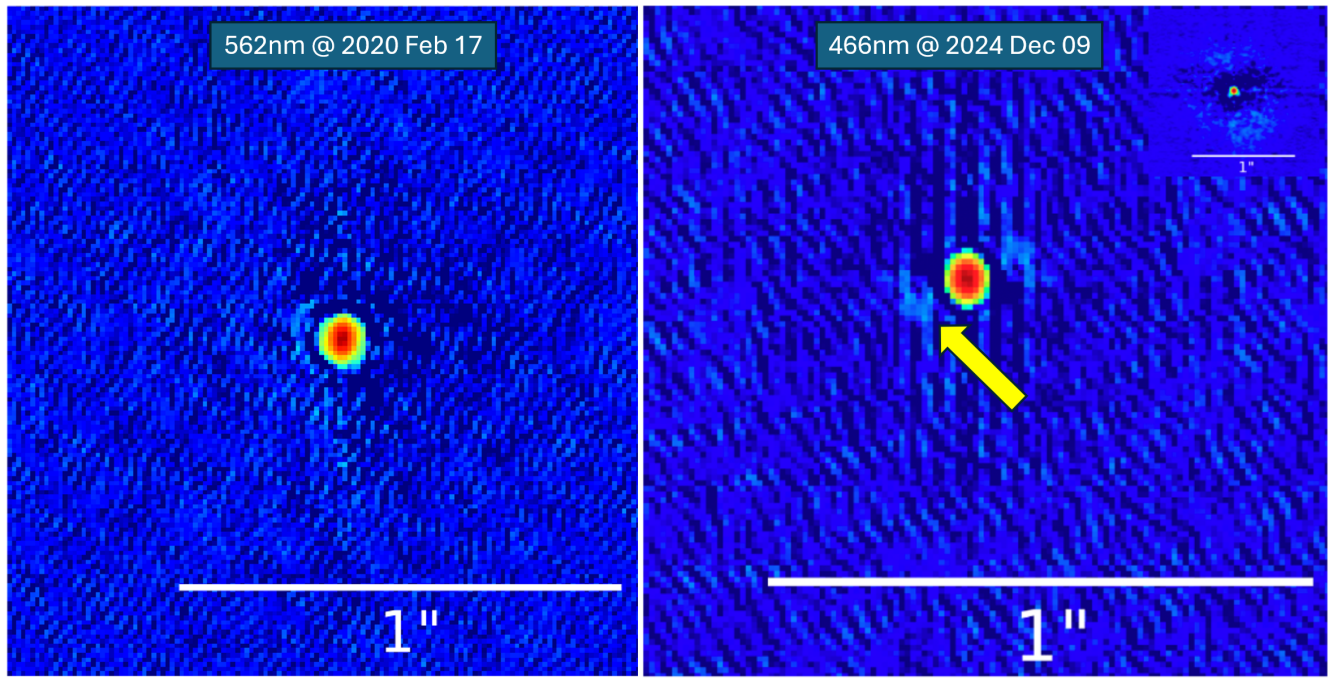The star Betelgeuse, a red supergiant marking the left shoulder of the Orion constellation, has long been the focus of astronomical observations, especially since its significant dimming episode a few years ago. Determining the exact size, evolutionary stage, and pulsation periods of the star could provide information on the question on the minds of many: when will the star explode as a supernova? (It is likely that we will have to wait another ten to a hundred thousand years for this to happen.) A particularly puzzling aspect of the star's light variation over a period of six years was resolved in 2024 when two independent groups concluded that the most likely cause was a companion star orbiting very close to the star (see our earlier reporting). The first article, written by Jared Goldberg (Flatiron Institute) and our former and current researchers, Meridith Joyce and László Molnár, predicted a celestial body probably larger than the Sun, orbiting the giant star at a distance of only 2.5 stellar radii. Calculations by Morgan MacLeod (Harvard University) and his colleagues predicted a smaller star in a similar orbit. The race to find Betelgeuse’s sibling, Betelbuddy, was on.
The three researchers who made the initial prediction wasted no time in working out ways to confirm their findings after the announcement. They formed a larger international group and submitted applications for telescope time on NASA's two still-operational large observatories, the Hubble and Chandra space telescopes. Chandra searched for X-ray emissions from a neutron star left over from a previous supernova explosion, while Hubble searched for ultraviolet emissions from the activity of a young, still-forming star. At longer wavelengths, however, Betelgeuse outshines its companion so much that there seemed to be no chance of detecting it.
However, the researchers were unsuccessful with either space telescope. Analysis of the Chandra observations were led by Anna O'Grady (Carnegie Mellon University), but even though the space telescope spent 12 hours staring at Betelgeuse, it did not detect any X-ray photons. So a compact celestial body interacting with the gas and dust surrounding the giant star was ruled out. The other possibility is that a normal, relatively low-mass star is orbiting Betelgeuse. Since smaller stars have slower life cycles, a Sun-like star would still be in the formation phase, before hydrogen fusion ignites in its core. Hubble's measurements therefore searched for the strong UV radiation characteristic of young star-like objects – but found none. Thus, the other scientific article led by Jared Goldberg could only provide upper limits for the companion's mass.

Chandra image of the supergiant star's surroundings. Each bright pixel represents a single detected X-ray photon. (Credits: CXO/NASA/ESA, O'Grady et al.)
How, then, can we confirm the existence of a companion that orbits very close to the supergiant but is ten to a hundred thousand times fainter? The direct imaging and coronagraphic instruments currently at our disposal did not seem suitable for this task. However, another research group, led by Stewe Howell (NASA Ames Research Center), had already taken high-resolution images of the star with the Gemini North giant telescope during the Great Dimming. They turned the telescope toward Betelgeuse again at the time of the companion's predicted maximum elongation. And they had a trick up their sleeve.
Gemini North is not only equipped with an 8.1-meter main mirror and adaptive optics that correct for changes in atmospheric turbulence, but also with a speckle imaging camera called `Alopeke. This instrument takes a series of images lasting only a hundredth of a second, then combines and specially processes the images to produce an image with a resolution of 0.015 arc seconds, reaching the theoretical resolution of the telescope.
The measurements collected at the end of 2024 show a faint spot that is clearly bluer than Betelgeuse, located at the predicted position and distance of Betelbuddy. The measurement alone is a little too weak to be conclusive, as the signal barely stands out from the background (its significance level is only 1.5 sigma), but the circumstances nevertheless lend additional support to its authenticity. In 2020, the companion should have been behind the supergiant, and nothing is visible in that image, yet now something is visible at the predicted location.

Betelgeuse and its companion in a processed image from the Gemini North telescope. The entire Orion constellation is shown in the background. (Credits: International Gemini Observatory/NOIRLab/NSF/AURA, M. Zamani (NSF NOIRLab))
However, this faint signal is much brighter than predicted by Goldberg, Joyce, and Molnár. According to this, Betelbuddy could be a larger, hotter (around A-B spectral type) celestial body with at least one and a half times the mass of the Sun, and "only" about a hundred times fainter than Betelgeuse. But why wasn't it visible in the Hubble measurements? The most likely explanation is that it is already quite close to igniting hydrogen and becoming a "real" star, so it is no longer as active in UV as smaller, still-forming young stars would be. Regardless, this system clearly demonstrates how strongly the rate of stellar evolution depends on the mass of stars. While Betelgeuse formed, lived most of its life, and is approaching a supernova explosion over 10 million years, Betelbuddy has not even reached the point where hydrogen fusion can begin.

Comparison of the 2020 and 2024 images. At the time of the former, the companion star was located behind Betelgeuse. (Credits: International Gemini Observatory/NOIRLab/NSF/AURA, Howell et al.)
Since the companion's observed signal is quite weak, full confirmation of the discovery will require seeing it disappear and then reappear on the other side of the star. Further observations will need to be made in the spring and summer of 2026 (i.e., at the end or beginning of Betelgeuse's nighttime visibility period) for the former, and at the end of 2027 for the latter.
The broader significance of the discovery lies in the fact that we have not seen such close companions to supergiant stars before, because we did not have the tools to detect them. At the same time, many supergiants (and smaller red giants) show long, multi-year variations in brightness. Until now, there has been no clear explanation for this, although binarity has always seemed to be one of the most likely causes. The observation of Betelgeuse's companion confirms this assumption: it now just needs to be verified in other giants, too.
Press release announcing the discovery: NOIRLab
Scientific article describing the discovery: arXiv